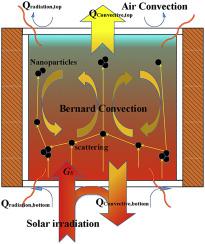Materials Today Energy ( IF 9.3 ) Pub Date : 2020-07-13 , DOI: 10.1016/j.mtener.2020.100480 K. Wang , Y. He , A. Kan , W. Yu , L. Wang , D. Wang , P. Liu , H. Xie , X. She

|
The nanofluids-based direct absorption solar collector (DASC) is considered as the next-generation solar collection technology due to its high photo-thermal conversion efficiency. However, the key challenges for its development are the large temperature gradients inside nanofluids and the agglomeration of nanoparticles. To address these issues, this paper proposes to apply solar irradiation at the bottom surface of the DASC (i.e. reverse irradiation) rather than at the top surface, which changes the heat transfer mode from heat conduction to heat convection. Experimental test is carried out for the first time for medium-temperature solar collection (~150 °C), where titanium nitride is selected as nanoparticles and therminol as base fluid. The experimental results show that reverse irradiation contributes to a uniform temperature distribution in nanofluids and results in a 36.4% higher photo-thermal conversion efficiency compared with the top irradiation; the maximum efficiency can reach up to 80%. What's more, the response time for nanofluids to achieve a steady-state temperature is shortened by 55.6%. One week test shows that reverse irradiation significantly improves the stability of nanofluids and mitigates the agglomeration of nanoparticles. Therefore, it can be concluded that the reverse irradiation DASC is a high-efficient, a fast-response and a long lifetime technology for solar collection.
中文翻译:

反向辐射增强基于热固醇的纳米流体,用于中温直接吸收太阳能收集
基于纳米流体的直接吸收式太阳能收集器(DASC)由于其高的光热转换效率而被认为是下一代太阳能收集技术。然而,其发展的关键挑战是纳米流体内部的大温度梯度和纳米颗粒的团聚。为了解决这些问题,本文建议在DASC的底面(即反向照射)而不是在顶面应用太阳辐射,这会将传热模式从导热转换为对流。首次进行了中温太阳能收集(〜150°C)的实验测试,其中选择了氮化钛作为纳米粒子,并使用了氨酚作为基础流体。实验结果表明,与顶部辐照相比,反向辐照有助于纳米流体中温度分布的均匀性,并提高了36.4%的光热转换效率。最高效率可达80%。此外,纳米流体达到稳态温度的响应时间缩短了55.6%。一项为期一周的测试表明,反向辐照可显着提高纳米流体的稳定性并减轻纳米颗粒的团聚。因此,可以得出结论,反向辐射DASC是一种高效,快速响应且寿命长的太阳能收集技术。纳米流体达到稳态温度的响应时间缩短了55.6%。一项为期一周的测试表明,反向辐照可显着提高纳米流体的稳定性并减轻纳米颗粒的团聚。因此,可以得出结论,反向辐射DASC是一种高效,快速响应且寿命长的太阳能收集技术。纳米流体达到稳态温度的响应时间缩短了55.6%。一项为期一周的测试表明,反向辐照可显着提高纳米流体的稳定性并减轻纳米颗粒的团聚。因此,可以得出结论,反向辐射DASC是一种高效,快速响应且寿命长的太阳能收集技术。



























 京公网安备 11010802027423号
京公网安备 11010802027423号